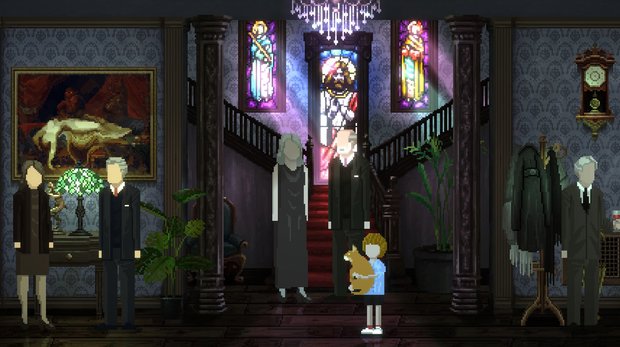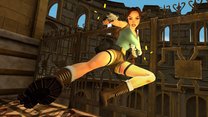Cats and the Other Lives review

- 0 Comments
Blend of feline playfulness and compellingly dark human drama purrs right along
Did you ever want to be a fly on the wall, to eavesdrop on people and see what goes on inside their homes, when they drop all pretenses and stop being who they are in public and let their true selves run free? What if you were a cat instead? At least then nobody would be swatting at you all the time, and it’s easier to take certain matters into your own hands – I mean, paws.
You get exactly that chance in Cultic Games’ Cats and the Other Lives. In this beautiful pixel art point-and-click adventure you control Aspen, an orange house cat, learning all secrets of the Mason family she resides with. You can engage in typical feline behavior like catching mice, jumping on everything and harassing people as an often hilarious way to take a break from the mysterious conversations you’ll be listening in on – it’s even good for a puzzle or two. You’ll laugh with the cat’s antics, but you’ll get chills from the human dealings. Because make no mistake: behaving like a cat might be (mostly) fun, but the deeper you delve into the family’s story, the darker and more horrific it gets.
Pater Familias Bernard Mason has passed away during the night, apparently from a heart attack suffered during a very lively nightmare. The game starts at his funeral, as he’s lying in state in his elaborate mansion in Hartford, Connecticut. Family and friends are gathered here as well, roaming the rooms and hallways.
The mansion and its inhabitants are designed with an antique, regal feel, fitting perfectly with the chosen setting. The rooms and hallways are filled with paintings, vases, sculptures, aged furniture, chandeliers, and books. The entire place creaks of old wood. You can hear doors open and close in the distance, the shuffling of feet, bumps and bonks and dripping water. The accompanying music is dominated by piano and changes according to the situation you encounter, often heightening the tension in a Hitchcockian fashion.

The people are faceless, and they display an irritating breathing animation where their upper bodies continuously move up and down, but this is the only critique I have when it comes to the early 90s graphical style. There are no voice-overs, but the characters will sometimes laugh or grumble, sigh or cry, stutter or make some other sound indicating their current mood.
Aspen, the house cat, is completely mouse-controlled (no pun intended). Click the cursor nearby and she trots over; click further away and she dashes off more quickly; hold down the mouse button and she keeps moving continuously. The view side-scrolls through the hallways until you stumble upon an open door you can enter. It’s a huge mansion with many places to visit, but Cats and the Other Lives gives a false feeling of exploration, since usually there’s only one possible place you can access at a given time. Progress is very linear, but since there’s always something to do and the rhythm of the game never drops, you don’t really notice that until you look back.
You’ll spend most of your time listening in on conversations, with all dialogue appearing in text balloons above the speaker’s head. There are two kinds of conversations. The first is common chitchat. People always have something to say, but it’s not always important. This type of exchange moves along automatically; you don’t have to click it away. Too bad if you’re a slow reader, though, since the text disappears a tad fast and there’s no option to adjust its speed. But since no real secrets are being divulged here, it’s usually not that big of a deal. In fact, you can choose to ignore these conversations completely and move on to other parts of the mansion.
The second kind IS important. These text balloons will stay on-screen until you click them away. These conversations are displayed as cut-scenes, made apparent by two black bands appearing at the top and bottom of the screen, narrowing the field of view. You can’t move Aspen during these narrative scenes, so she’ll sit down and start grooming herself until the conversation is over. But even here, the text advancement isn’t consistent. In some scenes, parts of the dialogue will move on automatically for some reason, while others do not. Being a lover of stories, I often wondered at this decision. The static ones are surely meant to be the most relevant to the plot and therefore not to be missed, but more than once I found the optional dialogue every bit as interesting and even insightful, showing secret alliances or even hatred between the different family members.

While at first glance Cats and the Other Lives looks like an innocent and playful experience, be forewarned that it’s not all fun and games. The storyline is full of darker elements than you’d expect. One character is constantly drinking, there are scenes containing domestic violence, you’ll see a couple half naked in bed, there are flashbacks to the sixties showing the hippie culture and its obligatory substance use, and as a final warning, without being too spoilery: there will be blood. All this makes the game unsuitable for younger players.
While the human conversations cover “the other lives” in the title, there’s also the “cats” part, and that’s where the actual gameplay comes in. Aspen can do more than just walk around and spy on people. The options are limited, but on occasion you can jump on, scratch or rub against furniture. The cursor will change into fitting icons to indicate what you can do, and where: double paws for jumping, one paw to tap something, scratch marks to scratch, a cat face to lick, a heart-shaped smiley face to rub against something or someone, and several more whose effects aren’t always immediately apparent.
In one hallway there’s a leaky ceiling and you can play with the puddle of water on the floor. Jumping on furniture will also give you the chance to sniff peculiar items, even the wreath next to Bernard’s coffin. Sniffing these items unlocks collectible memories in the form of close-ups, which you can later peruse through the designated menu option. Some close-ups will show text incorporated in the graphics, like the label on the wreath. Should it be too hard to read – and usually it is totally illegible – simply click the available icon to see it subtitled.
At one point you discover a mouse hiding under a couch, and your cursor gives you three possibilities in something resembling a verb coin. You can sniff, you can jump, and you can crouch. You can only catch the mouse if you choose not only the correct commands, but also use them in the correct order. Do the wrong thing (or the right thing at the wrong time) and you may simply scare the mouse away or fail to pounce successfully.

Another time you’ll find yourself stuck in a garbage can. The cursor changes to indicate you must move the mouse quickly from left to right and back to build up momentum and tip over the can. With most new actions to perform, a short description of what you have to do is shown at the top of the screen, but not always. In one room I had to chase a beetle, but it always crawled out of reach. I had no idea what I was doing wrong, and at first I thought I had to approach from another direction or something. Turned out it was a timed event and I just wasn’t fast enough. Take too long to jump, and the bug escapes.
It’s not always possible to enter a room. Sometimes you have to wait for a human to open the door before the icon pops up. You’ll have to time your own entry very carefully, since doors tend to close again very quickly, and then you’ll have to wait for the next person to enter or exit. Sometimes Cats and the Other Lives doesn’t allow you to enter a room even when other characters have opened the door. In these instances, the exit icon won’t appear, which means you’ll have to do something else in the current room first. Then suddenly, the door in question opens on its own, which is a bit strange but the game has something of a “haunted mansion” theme woven throughout the storyline, so in that sense it sort of fits.
The opposite can also be true. You’ll often find yourself stuck in a room with no way out. The puzzle here is figuring out what you can do to trigger someone inside the room with you to open a door or a window. Sometimes it’s simply meowing at them when standing in the right spot, while other times you’ll need to more strategically interact with things in the room to achieve the desired result. There are a whole bunch of creative ways to keep players occupied with the many variations of this enter-or-escape-the-room puzzle, and they all feel very naturally fitting with a common cat being the main character.
Less fun are some annoying arcade-like sequences. One is chasing a mouse along the pipes inside the walls. You have to stay right behind the critter, avoid obstacles, and jump up or down at the right times. Fail one step and you wind up back at the start. Same with climbing a tree to chase a murder of crows. They drop stones on your head, so you have to swerve left and right at the exact right moment or else you wind up at the bottom again. These sequences annoyed me. They may be appropriate to the life of a cat and they’re not very long, but you still have to persevere through them since there’s no skip function.
Many people say that animals are known to sense things we humans can’t. This is indeed the case for Aspen. She can detect when something is going on in another room, shown by several wavy lines pointing in the right direction. These lines work similarly to a Wi-Fi connection; move further away, and you’ll see fewer lines. Get closer again, and all lines will appear again. This type of ESP, if you will, guides you through the storyline and lets you know where something important is going on.
Aspen often sees ghosts, or better called remnants of the past. You’ll see younger versions of the main cast in all kinds of situations, showing all the details of the Mason family throughout the years in flashback form. There’s no in-game notebook (you are a cat, after all), but while playing I had fun compiling the Mason family tree of my own to keep track of everyone and their relationships.
But Aspen has more normal animal traits as well, like the ability to follow scents. When the family’s little boy suddenly goes missing, you can sniff one of his belongings. The boy’s scent will appear in the air in front of you, showing you the direction in which to search. Then it’s simply a case of following this animal world’s version of a GPS.
Cats and the Other Lives has no manual save, and it’s not very apparent when the auto-save triggers exactly. At first I thought it was after important conversations, even after switching rooms. Unfortunately, experience taught me otherwise, and I had to redo entire conversations after exiting the game apparently too early. The game should take about seven hours to complete, so you’ll need to take a break at some point, although it’s so entertaining, tense and mysterious, you’d have to have a good reason to pull yourself away from it!
Final Verdict
The strength of Cats and the Other Lives is the combination of its playful main character and a storyline that can be quite disturbing at times. Even pixel art can become quite graphic, and the writers didn’t hold back when compiling their tale of adult themes showing all aspects of human nature. The fun gameplay lightens the mood, however, and acting like a cat with both its physical limitations and natural abilities offers some enjoyable challenges and puzzles. You’ll probably find yourself ignoring the obvious signposts and exploring the mansion first to make sure you don’t miss anything optional. Learning the secrets of the Mason family becomes very addictive, and discovering its history piecemeal will both confirm some of your suspicions and surprise you with some crazy bends in the road. There are many emotional ups and downs, but even with a few minor gameplay and interface annoyances on occasion, like a good cat the story always manages to land on its feet.
Hot take
Being a feline makes Cats and the Other Lives a fun and playful game for the most part, though the storyline you uncover along the way gets darker and darker, and all the more compelling because of it.
Pros
- It’s always fun playing as a cat
- Classic pixel art style fits the mood and setting
- Creative puzzles that take full advantage of a cat’s abilities
- Intriguing family history keeps you motivated to keep learning more
Cons
- Text speed of casual conversations may be too fast
- No manual save, and special actions could’ve used better instructions
- Some tricky arcade sequences
Johnny played Cats and the Other Lives on PC using a review code provided by the game's publisher.










0 Comments
Want to join the discussion? Leave a comment as guest, sign in or register.
Leave a comment